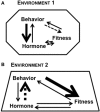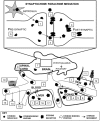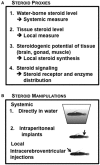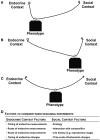Contextual modulation of social and endocrine correlates of fitness: insights from the life history of a sex changing fish
- PMID: 25691855
- PMCID: PMC4315020
- DOI: 10.3389/fnins.2015.00008
Contextual modulation of social and endocrine correlates of fitness: insights from the life history of a sex changing fish
Abstract
Steroid hormones are critical regulators of reproductive life history, and the steroid sensitive traits (morphology, behavior, physiology) associated with particular life history stages can have substantial fitness consequences for an organism. Hormones, behavior and fitness are reciprocally associated and can be used in an integrative fashion to understand how the environment impacts organismal function. To address the fitness component, we highlight the importance of using reliable proxies of reproductive success when studying proximate regulation of reproductive phenotypes. To understand the mechanisms by which the endocrine system regulates phenotype, we discuss the use of particular endocrine proxies and the need for appropriate functional interpretation of each. Lastly, in any experimental paradigm, the responses of animals vary based on the subtle differences in environmental and social context and this must also be considered. We explore these different levels of analyses by focusing on the fascinating life history transitions exhibited by the bi-directionally hermaphroditic fish, Lythrypnus dalli. Sex changing fish are excellent models for providing a deeper understanding of the fitness consequences associated with behavioral and endocrine variation. We close by proposing that local regulation of steroids is one potential mechanism that allows for the expression of novel phenotypes that can be characteristic of specific life history stages. A comparative species approach will facilitate progress in understanding the diversity of mechanisms underlying the contextual regulation of phenotypes and their associated fitness correlates.
Keywords: androgen; cortisol; parenting; reproduction; social status.
Figures









Similar articles
-
Contextual modulation of androgen effects on agonistic interactions.Horm Behav. 2014 Jan;65(1):47-56. doi: 10.1016/j.yhbeh.2013.11.006. Epub 2013 Dec 5. Horm Behav. 2014. PMID: 24315925
-
Do hormone manipulations reduce fitness? A meta-analytic test of the Optimal Endocrine Phenotype Hypothesis.Mol Cell Endocrinol. 2020 Jan 15;500:110640. doi: 10.1016/j.mce.2019.110640. Epub 2019 Nov 9. Mol Cell Endocrinol. 2020. PMID: 31715223 Review.
-
Relationships between Endocrine Traits and Life Histories in Wild Animals: Insights, Problems, and Potential Pitfalls.Integr Comp Biol. 2016 Aug;56(2):185-97. doi: 10.1093/icb/icw051. Epub 2016 Jun 1. Integr Comp Biol. 2016. PMID: 27252190 Review.
-
Hormones, life-history, and phenotypic variation: opportunities in evolutionary avian endocrinology.Gen Comp Endocrinol. 2012 May 1;176(3):286-95. doi: 10.1016/j.ygcen.2011.11.028. Epub 2011 Dec 1. Gen Comp Endocrinol. 2012. PMID: 22154573 Review.
-
Endocrine mechanisms, behavioral phenotypes and plasticity: known relationships and open questions.Front Zool. 2015 Aug 24;12 Suppl 1(Suppl 1):S7. doi: 10.1186/1742-9994-12-S1-S7. eCollection 2015. Front Zool. 2015. PMID: 26816524 Free PMC article. Review.
Cited by
-
Sex diversity in the 21st century: Concepts, frameworks, and approaches for the future of neuroendocrinology.Horm Behav. 2024 Jan;157:105445. doi: 10.1016/j.yhbeh.2023.105445. Epub 2023 Nov 17. Horm Behav. 2024. PMID: 37979209 Free PMC article.
-
Preparing to migrate: expression of androgen signaling molecules and insulin-like growth factor-1 in skeletal muscles of Gambel's white-crowned sparrows.J Comp Physiol A Neuroethol Sens Neural Behav Physiol. 2019 Feb;205(1):113-123. doi: 10.1007/s00359-018-1308-7. Epub 2018 Dec 8. J Comp Physiol A Neuroethol Sens Neural Behav Physiol. 2019. PMID: 30535830
-
3β-HSD expression in the CNS of a manakin and finch.Gen Comp Endocrinol. 2018 Jan 15;256:43-49. doi: 10.1016/j.ygcen.2017.09.016. Epub 2017 Sep 18. Gen Comp Endocrinol. 2018. PMID: 28935582 Free PMC article.
References
-
- Alcock J. (2001). Animal Behavior: An Evolutionary Approach, 7th Edn. Sunderland, MA: Sinauer Associates Inc.
-
- Angelier F., Weimerskirch H., Dano S., Chastel O. (2006). Age, experience and reproductive performance in a long-lived bird: a hormonal perspective. Behav. Ecol. Sociobiol. 61, 611–621 10.1007/s00265-006-0290-1 - DOI
-
- Apfelbeck B., Mortega K. G., Kiefer S., Kipper S., Goymann W. (2013). Life-history and hormonal control of aggression in black redstarts: blocking testosterone does not decrease territorial aggression, but changes the emphasis of vocal behaviours during simulated territorial intrusions. Front. Zool. 10:8. 10.1186/1742-9994-10-8 - DOI - PMC - PubMed
-
- Arterbery A. S., Deitcher D. L., Bass A. H. (2010). Divergent expression of 11β-hydroxysteroid dehydrogenase and 11β-hydroxylase genes between male morphs in the central nervous system, sonic muscle and testis of a vocal fish. Gen. Comp. Endocrinol. 167, 44–50. 10.1016/j.ygcen.2010.02.021 - DOI - PMC - PubMed
Publication types
LinkOut - more resources
Full Text Sources
Other Literature Sources

